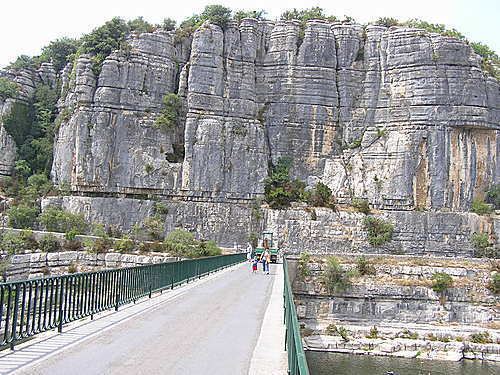Area 18.9 km² | Canton Vallon-Pont-d'Arc Population (2010) 341 Local time Tuesday 10:02 PM | |
 | ||
Weather 5°C, Wind E at 3 km/h, 71% Humidity | ||
Balazuc ard che
Balazuc is a French commune in the Ardèche department in the Auvergne-Rhône-Alpes region of southern France.
Contents
- Balazuc ard che
- Map of 07120 Balazuc France
- Saut de 15 metres du pont de balazuc ardeche
- Geography
- History
- Administration
- Demography
- Civil heritage
- Religious heritage
- Environmental heritage
- Cultural events
- Notable people linked to the commune
- References
Map of 07120 Balazuc, France
The village has been labelled a "Village of Character" by the Departmental Committee of Tourism. It is a member of Les Plus Beaux Villages de France (The most beautiful villages in France) Association.
The inhabitants of the commune are known as Balazucains or Balazucaines.
Saut de 15 metres du pont de balazuc ardeche
Geography
Balazuc is located some 16 km south of Aubenas just east of Uzer. Aubenas Aerodrome is just north of the commune. Access to the commune is by the D579 road from Vogüé in the north which passes through the commune east of the village and continues to Pradons in the south. The D294 branches off the D579 in the commune and goes west to the village. Apart from the village there are also the hamlets of Servière, Translatour, Le Retourtier, and Les Louanes in the commune. The commune is forested in the west and east with large areas of farmland in the centre.
The Ardèche river flows through the commune and the village from north to south where it forms part of the southern border before continuing south to join the Rhône at Pont-Saint-Esprit. Numerous tributaries rise on both banks of the Ardèche and flow into the river including the Ruisseau de Mariou, the Ruisseau de Chadenas, the Ruisseau de Chastagnon, the Ruisseau de Tison, and the Ruisseau des Costes.
History
For millennia Balazuc has been the site of a ford on the Ardèche river which was a Gallic stronghold. The name Balazuc comes from the name Baladunum of bal meaning "rock" and "dunum" or "fortified height" in Gallic
Balazuc has the remains of Neanderthal men who hunted ibex there over 50,000 years ago at the beginning of the last ice age. Farmers arrived in the Neolithic period around 3000 BC. to raise goats and sheep, cultivate the bottom of the depressions, and place their dead in mass graves in stone coffins.
In the Late Bronze Age, around 750 BC., the ford below the village was used. The Gauls, for whom there is no trace, gave it its name: Baladunum. The Gallo-Romans cultivated the Plain des Salles where the great Roman road passed between the Rhône and Nîmes. An early Christian sarcophagus has been found whose high reliefs include biblical scenes (a facsimile is displayed in the town hall). In the Middle Ages the village had a church and a castle from the 11th to 13th centuries in an enclosure which dates them. The castle was originally built in the 12th century and greatly enlarged in the 13th century with a square keep. The ramparts, keep, noble houses, and fortified houses are well preserved.
The village underwent an evolution of houses across the centuries but retained its originality and the medieval character of the village with its narrow streets and its "callades".
Pons de Balazuc, the son of Gérard de Balazuc, was one of the first known lords. He went on the first crusade and was killed just before the capture of Jerusalem in 1099 at the Siege of Arqa (at the archaeological site of Tel Arqa) near Tripoli (now in Lebanon).
Administration
List of Successive Mayors
(Not all data is known)
Demography
In 2010 the commune had 341 inhabitants. The evolution of the number of inhabitants is known from the population censuses conducted in the commune since 1793. From the 21st century, a census of communes with fewer than 10,000 inhabitants is held every five years, unlike larger communes that have a sample survey every year.
Sources : Ldh/EHESS/Cassini until 1962, INSEE database from 1968 (population without double counting and municipal population from 2006)
Civil heritage
Religious heritage
Environmental heritage
Cultural events
The Roche-Haute Association since 1982 has organised concerts and exhibitions of paintings in the Romanesque church including paintings by: Guillaume Beaugé, Jacques Dromart, and Erik Levesque.
